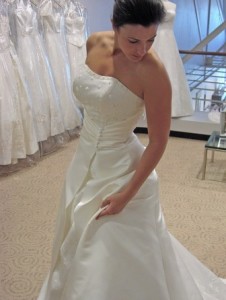 Queen Victoria set the stage at her 1840 wedding by wearing a white bridal gown. White came to signify joy rather than virginity, and is now considered an appropriate color for all brides, including those marrying again. White, in many of its’ hues and pastel tints, is still a conventional and long standing choice for bridal gowns, but other colors are just as acceptable. The ultimate decision about the color belongs solely to the bride.
Queen Victoria set the stage at her 1840 wedding by wearing a white bridal gown. White came to signify joy rather than virginity, and is now considered an appropriate color for all brides, including those marrying again. White, in many of its’ hues and pastel tints, is still a conventional and long standing choice for bridal gowns, but other colors are just as acceptable. The ultimate decision about the color belongs solely to the bride.
The bride’s shoes are traditionally satin or peau de soie, that are dyed to match the gown. Comfort is of utmost importance. It’s OK to wear low-heeled shoes, sandals, etc. which are hidden under a long gown anyway. The Wedding Day is a long day, so it is important to be comfortable.
Gloves can enhance the overall look of a wedding dress. Gloves range in fabric from cotton and soft kid to satin and lace and should complement the wedding gown. When considering the length and type of gloves to be worn, keep in mind that short, loose gloves can be easily removed by the bride and handed to the maid of honor during the ring exchange ceremony. Tight or long gloves can be trickier to remove and can cause unneeded stress. Finger-less gloves are another option of solving the ring-finger problem.
The traditional jewelry worn by the bride on her Wedding Day is classic in design and neutral in color, such as a pearl or diamond-and-pearl necklace and earrings or simple gold ornaments. Colored stones, heirloom family jewelry, jewelry gift from the groom are all acceptable and should not distract from the bride’s overall look. Ultimately, the bride has the final fashion statement in regards to jewelry. However, if this is an encore wedding for the bride, she should not wear any engagement or wedding bands from a previous marriage.